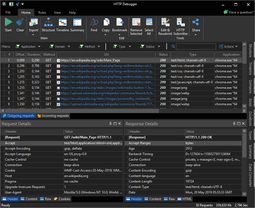Understanding of HTTP Traffic Analysis
Knowing how to analyze HTTP/s traffic provides you with 'who, what and when information' about activity on your network.
This information can be used to improve the performance, the security and the general management of the network. HTTP/s
traffic analysis tools should provide sufficient information to effectively troubleshoot network issues, prevent
unauthorized activity or identify unused network resources.
Most developers remain unaware of exactly how their application is interacting with the web browsers installed on their clients’ machines. Tracing and monitoring HTTP traffic in real time provides web developers with a lot of information. It helps to record all the HTTP traffic that passes between the computer and the Internet. The required information includes Header values, Cookies, Content, Post data, Query Strings, Redirection URLs, Request and Response Stream, Cache information, HTTP status code information and more.
By providing data, HTTP traffic analysis can identify bottlenecks in the network; see what applications are hogging resources and bandwidth, and alert administrators to trends in file name changes. Alerts can be set up to advise administrators of any unusual activity or network anomalies, thus mitigating the risks of standard port numbers being used for non-standard purposes, malware, and insider theft.
Data sent and received over the protocol between the computer and the web server is network traffic. It refers to the amount of data moving across a network at a given point of time. Network data is mostly encapsulated in network packets, which provide the load in the network.
Packets are classified to be differently processed by the network schedule. A particular protocol, a predetermined policy can be applied to HTTP traffic flows. This policy can either guarantee a certain quality or provide best-effort delivery. It may be applied in a way that allows HTTP traffic management mechanisms to separate traffic into individual flows and queue, police and shape them differently.
Software developers may use an HTTP sniffer tool to see all network traffic (both HTTP and HTTPS) between their application and the Internet and troubleshoot weird situations.
Packet sniffers are excellent for monitoring the use of the network at any time, helping network administrators to identify whether a certain network is overcrowded or not, identify bottlenecks and improve performance. A packet sniffer can analyze the conversation between network nodes and, in the case of an error, discover invalid packets and identify the network node that failed to respond.
HTTP Debugger is an example of a packet sniffer that uses a software driver to intercept the network traffic and that can capture & decode the HTTPS traffic.
Most developers remain unaware of exactly how their application is interacting with the web browsers installed on their clients’ machines. Tracing and monitoring HTTP traffic in real time provides web developers with a lot of information. It helps to record all the HTTP traffic that passes between the computer and the Internet. The required information includes Header values, Cookies, Content, Post data, Query Strings, Redirection URLs, Request and Response Stream, Cache information, HTTP status code information and more.
By providing data, HTTP traffic analysis can identify bottlenecks in the network; see what applications are hogging resources and bandwidth, and alert administrators to trends in file name changes. Alerts can be set up to advise administrators of any unusual activity or network anomalies, thus mitigating the risks of standard port numbers being used for non-standard purposes, malware, and insider theft.
Data sent and received over the protocol between the computer and the web server is network traffic. It refers to the amount of data moving across a network at a given point of time. Network data is mostly encapsulated in network packets, which provide the load in the network.
Packets are classified to be differently processed by the network schedule. A particular protocol, a predetermined policy can be applied to HTTP traffic flows. This policy can either guarantee a certain quality or provide best-effort delivery. It may be applied in a way that allows HTTP traffic management mechanisms to separate traffic into individual flows and queue, police and shape them differently.
Software developers may use an HTTP sniffer tool to see all network traffic (both HTTP and HTTPS) between their application and the Internet and troubleshoot weird situations.
Packet sniffers are excellent for monitoring the use of the network at any time, helping network administrators to identify whether a certain network is overcrowded or not, identify bottlenecks and improve performance. A packet sniffer can analyze the conversation between network nodes and, in the case of an error, discover invalid packets and identify the network node that failed to respond.
HTTP Debugger is an example of a packet sniffer that uses a software driver to intercept the network traffic and that can capture & decode the HTTPS traffic.
Copyright Notice: Please don't copy or translate this article without prior written permission
from the HTTPDebugger.com
HTTP Debugger is a proxy-less HTTP analyzer for developers that provides the ability to capture and analyze HTTP headers,
cookies, POST params, HTTP content and CORS headers from any browser or desktop application.
Awesome UI and very easy to use. Not a proxy, no network issues!
Download FREE 7-Day Trial
HTTP Debugger
 Debug HTTP API calls to a back-end and between back-ends.
Very easy to use.
Not a proxy, no network issues!
Download Free Trial
Debug HTTP API calls to a back-end and between back-ends.
Very easy to use.
Not a proxy, no network issues!
Download Free Trial



